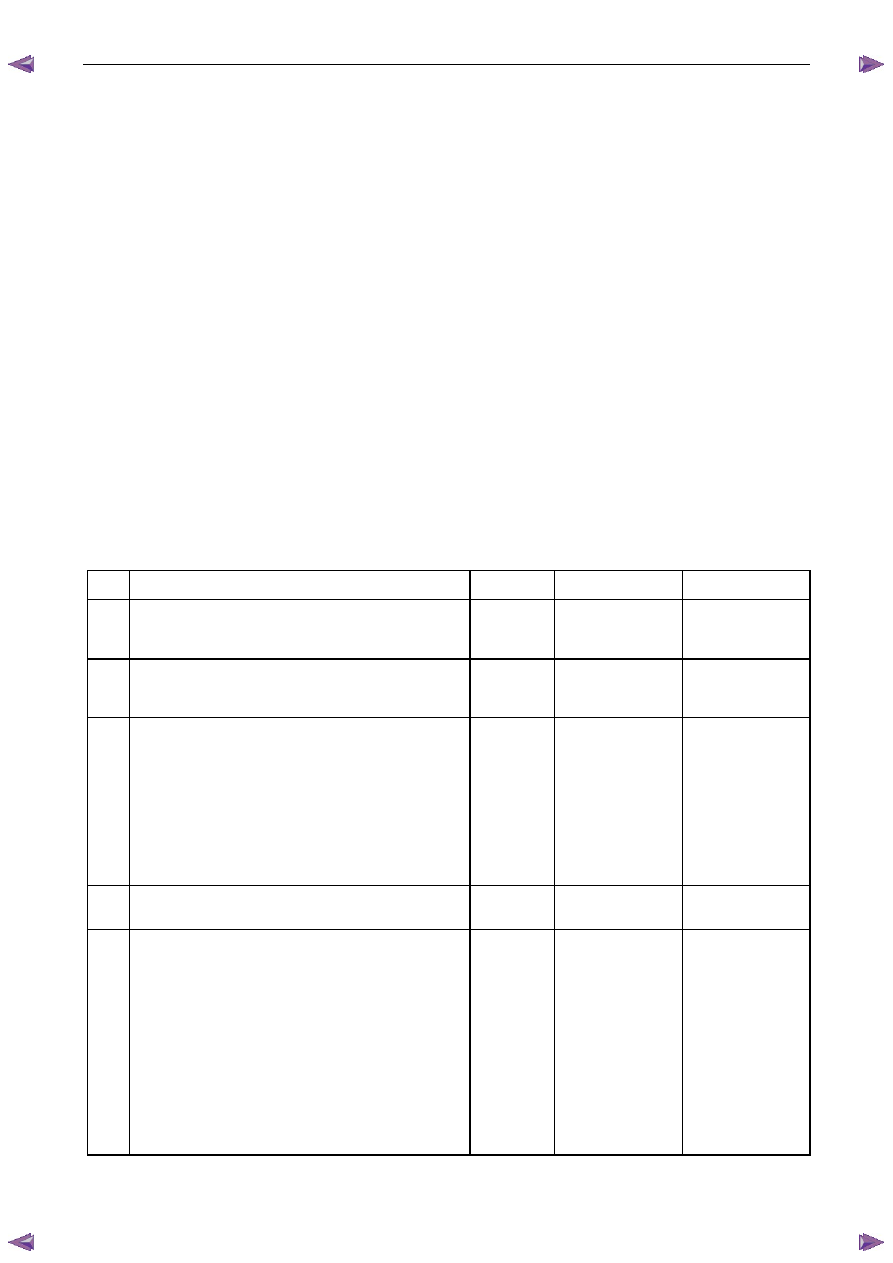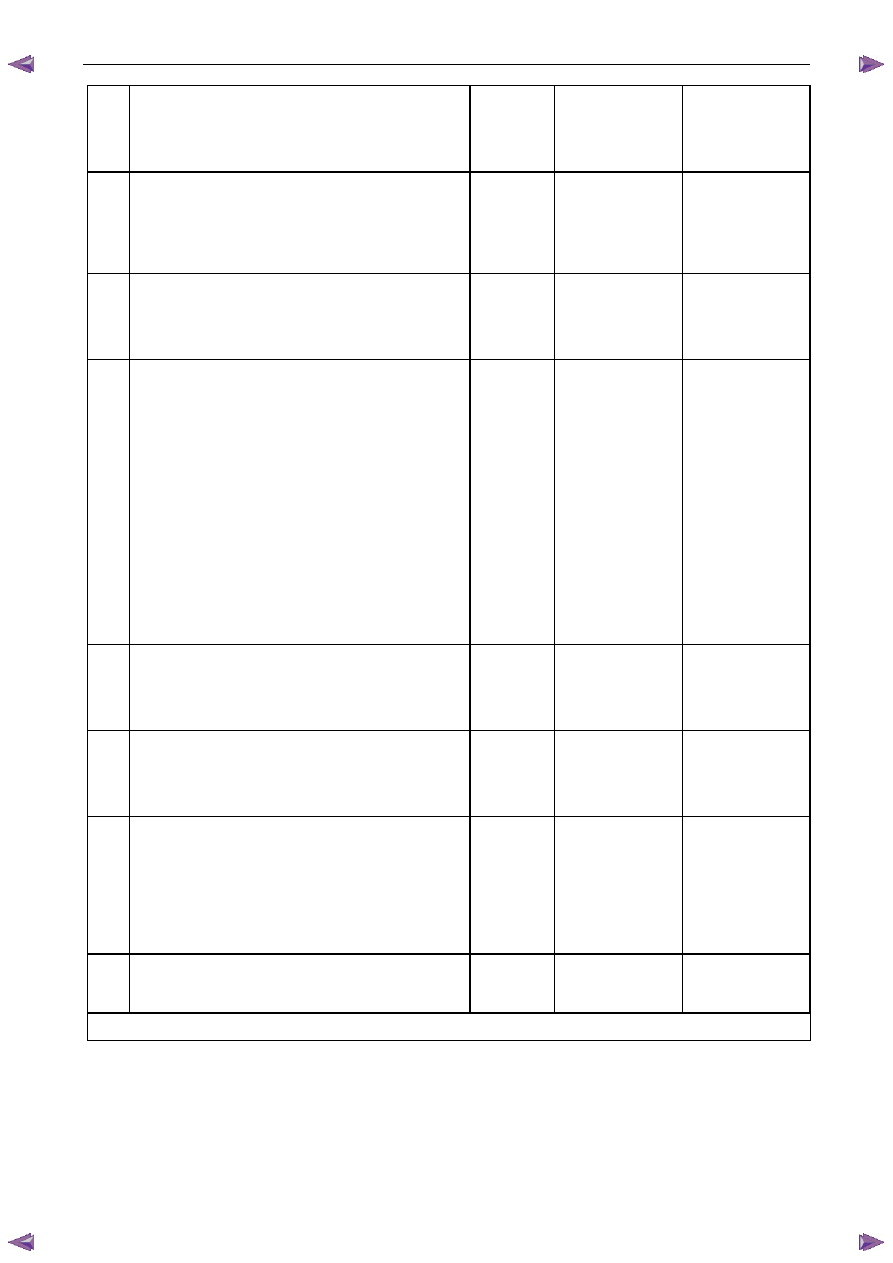Isuzu KB P190. Manual — part 831
Engine Management – V6 – Diagnostics
Page 6C1-2–46
6.5
Alcohol / Contaminants in Fuel
Diagnosis
Description
Water contamination in the fuel system may cause driveability conditions such as hesitation, stalling, no start, or
misfires in one or more cylinders. Water may collect near a single fuel injector at the lowest point in the fuel rail, and
cause a misfire in that cylinder. If the fuel system is contaminated with water, inspect the fuel system components for
rust, or deterioration.
Alcohol (e.g. Ethanol) concentrations more than 10% in the fuel can be detrimental to fuel system components. Alcohol
contamination may cause fuel system corrosion, deterioration of rubber components, and subsequent fuel filter
restriction. Fuel contaminated with alcohol may cause driveability conditions such as hesitation, lack of power, stalling,
or no start. Some types of alcohol are more detrimental to fuel system components than others.
Alcohol in Fuel Testing Procedure
N O T E
The procedures detailed are not intended to be
accurate but rather, indicative of a contamination
situation.
The fuel sample should be drawn from the bottom of the tank so that any water present in the tank will be detected. The
sample should be bright and clear. If alcohol contamination is suspected, then use the following procedure to test the
fuel quality.
•
Using a 100 ml graduated cylinder with 1 ml marks, fill the cylinder with fuel to the 90 ml mark.
•
Add 10 ml of water to bring the total fluid volume to 100 ml and install a stopper.
•
Shake the cylinder vigorously for 10 – 15 seconds.
•
Carefully loosen the stopper to release the pressure.
•
Re-install the stopper and shake the cylinder vigorously again for 10 – 15 seconds.
•
Put the cylinder on a level surface for approximately 5 minutes to allow adequate liquid separation.
If alcohol is present in the fuel, the volume of the lower layer, that now contains both alcohol and water, will be more
than 10 ml. For example, if the volume of the lower layer is increased to 15 ml, this indicates at least 5 percent alcohol in
the fuel. The actual amount of alcohol may be somewhat more because this procedure does not extract all of the
alcohol from the fuel. To obtain an accurate determination of the amount of alcohol contamination in a given fuel sample,
then professional analysis should be sought.
Particulate Contaminants in Fuel Testing Procedure
The fuel sample should be drawn from the bottom of the tank so that any contaminants present in the tank will be
detected. The sample should be bright and clear. If the sample appears cloudy or contaminated with water as indicated
by a water layer at the bottom of the sample, use the following procedure to diagnose the fuel.
•
Using an approved fuel container, draw approximately 0.5 litre of fuel.
•
Place the cylinder on a level surface for approximately 5 minutes to allow settling of the particulate contamination.
Particulate contamination will show up in various shapes and colours. Sand will typically be identified by a white or light
brown crystals. Rubber will appear as black and irregular particles. If particles are found, clean the entire fuel system
thoroughly. Refer to 6C Fuel System – V6.
6.6
Crankshaft Position (CKP) System
Variation Learn Procedure
Description
The crankshaft position system variation learn feature is carried out automatically on the HFV6 engine under decel with
fuel cut. The road speed and duration of the self-learn process varies with different vehicle equipment levels such as
transmission, final drive ratio etc.
The variation learn procedure cannot be over-written, nor can it be accessed with Tech 2.
Engine Management – V6 – Diagnostics
Page 6C1-2–47
6.7
Throttle Body Relearn
A throttle body relearn procedure is performed in one of two ways:
•
Engine Control Module initiated throttle body relearn, or
•
Tech 2 initiated throttle body relearn.
Engine Control Module Throttle Body Relearn
The engine control module (ECM) will automatically perform a throttle body relearn procedure if either of the following
conditions exist:
•
The battery has been disconnected, or
•
The ignition switch is in the ON position for greater than 29 seconds, and the following conditions are met:
−
Engine speed is less than 40 rpm,
−
Vehicle speed is 0 km/h,
−
Engine coolant temperature is 5 – 60°C,
−
Intake air temperature is 5 – 60°C,
−
Accelerator pedal position sensor angle is less than 14.9%, and
−
Ignition voltage is greater than 10 V.
Tech 2 Throttle Body Relearn
To perform a throttle body relearn using Tech 2, complete the following procedure:
N O T E
Tech 2 will not initiate a throttle body relearn if
the engine is running.
1
Connect Tech 2 to the data link connector (DLC) and turn the ignition on.
2
On Tech 2 select Engine / Programming / Throttle Body Relearn.
3
When Tech 2 displays ‘Do you really want to Reset?’, press the ‘Yes’ soft key.
4
When Tech 2 displays ‘Programming Completed’, and the electronic throttle control value displayed by Tech 2 is
‘11’, press the ‘Confirm’ soft key to return to the Tech 2 Programming screen.
5
The throttle body relearn is now complete.
6.8
Electronic Ignition (EI) System Diagnosis
Circuit Description
The engine control module (ECM) controls the ignition coils by pulsing the ignition control (IC) circuits, which triggers an
ignition coil and fires the spark plug. The ECM controls the sequencing and the timing of each ignition coil. The ignition
system consist of the following components:
•
The six ignition coils
•
The crankshaft position (CKP) sensor
•
The four camshaft position (CMP) sensors
•
The ECM
The ignition coils use the following circuits:
•
An IC circuit
•
An ignition 1 voltage circuit
•
Two ground circuits

Engine Management – V6 – Diagnostics
Page 6C1-2–48
Additional Information
•
Use the J 35616-B Connector Test Adapter Kit for any test that requires probing the ECM harness connector or a
component harness connector.
•
Inspect the ignition coils for aftermarket devices. An aftermarket device connected to the ignition coil circuits, may
cause a condition with the ignition coils.
•
For an intermittent fault condition, refer to 5.2
Intermittent Fault Conditions in this Section.
•
To assist diagnosis, refer to 3 Wiring Diagrams and Connector Charts in this Section, for the system wiring
diagram and connector charts.
Test Description
The numbers below refer to the step numbers on the diagnostic table.
4
The ignition coils for each bank are fused separately. If a fuse opens or the ignition 1 voltage circuit opens
between the fuse and the splice, all the ignition coils for one bank of the engine would be inoperative. If the ground
circuit opens at the engine block, the ignition coils would be inoperative for one bank of the engine.
5
This step tests for an open or a high resistance in the ignition 1 voltage circuit of the ignition coil. If the DMM does
not display near battery voltage there is an open or a high resistance in the circuit.
6
This step determines if the ground circuit is open. If the circuit is open, the ignition coils would be inoperative for
one bank of the engine.
7
This step determines if the ignition 1 voltage circuit is shorted to ground. If the fuse is open, the ignition coils would
be inoperative for one bank of the engine.
Diagnostic Table
Step Action Value(s)
Yes
No
1
Has the Diagnostic System Check been performed?
—
Go to Step 2
Refer to
4.4 Diagnostic
System Check
2
Were you sent here from DTC P0300 or P0301-P0306?
—
Go to Step 3
Go to DTC P0300 or
DTC P0301 –
P0306
3
1
Start the engine.
2
Allow the engine to reach operating temperature.
3
Operate the engine at 2,000 rpm.
4
Monitor all of the Misfire Current Counters with a
scan tool. There are a total of 6 counters,
1 counter per cylinder.
Are any of the Misfire Current Counters incrementing?
—
Go to Step 4
Go to
5.2 Intermittent
Fault Conditions
4
Are all the misfire counters incrementing for one bank
of the engine?
—
Go to Step 7
Go to Step 5
5
1 Ignition
OFF.
2
Disconnect the appropriate ignition coil.
3
Ignition ON, engine OFF.
4
Connect a test lamp between the battery voltage
circuit of the ignition coil and a good ground.
5
Measure the voltage between the probe of the
test lamp and a good ground with a DMM. Refer
to 8A Electrical - Body and Chassis for the
procedure to measure voltage drop.
Is the voltage at the specified value?
B+
Go to Step 6
Go to Step 9

Engine Management – V6 – Diagnostics
Page 6C1-2–49
6
1
Connect the test lamp between the battery
voltage circuit of the ignition coil and to each
ground circuit of the ignition coil.
Does the test lamp illuminate at each ground circuit?
—
Go to Step 8
Go to Step 10
7
1
Test the battery voltage circuit for an open or high
resistance at the splice of the affected bank of
ignition coils. Refer to 8A Electrical - Body and
Chassis for circuit testing procedures.
Did you find and correct the condition?
—
Go to Step 12
Go to Step 10
8
1
Test for an intermittent and for a poor connection
at the ignition coil. Refer to 8A Electrical - Body
and Chassis for circuit testing procedures.
Did you find and correct the condition?
—
Go to Step 12
Go to Step 11
9
N O T E
The battery voltage circuit is shared with
other components. Disconnecting a
component on the shared battery voltage
circuit may isolate a shorted component.
Review the electrical schematic and
diagnose the shared circuits and
components.
1
Repair a short to ground, an open or high
resistance in the ignition 1 voltage circuit. Refer to
Refer to 8A Electrical - Body and Chassis for
wiring repair procedures.
2
Replace the fuse as necessary.
Did you complete the repair?
—
Go to Step 12
—
10
1
Repair the open or high resistance in the ground
circuit. Refer to 8A Electrical - Body and Chassis
for wiring repair procedures.
Did you complete the repair?
—
Go to Step 12
—
11
1
Replace the ignition coil. Refer to 2.15 Ignition
Coils, in 6C1-3 Engine Management – V6 –
Service Operations.
Did you complete the replacement?
—
Go to Step 12
—
12
1
Connect all disconnected components.
2
Use Tech 2 to clear the DTC/s.
3
Start the engine.
4
Observe the Capture Info with Tech 2.
Do any of the misfire counters increment?
—
Go to Step 2
Go to Step 13
13
1
Using Tech 2, select the DTC display function.
Does Tech 2 display any DTCs?
—
Go to the
appropriate DTC
Table in this Section
System OK
When all diagnosis and repairs are completed, clear all DTCs and verify correct operation

Нет комментариевНе стесняйтесь поделиться с нами вашим ценным мнением.
Текст